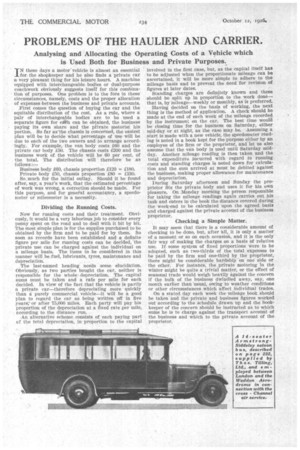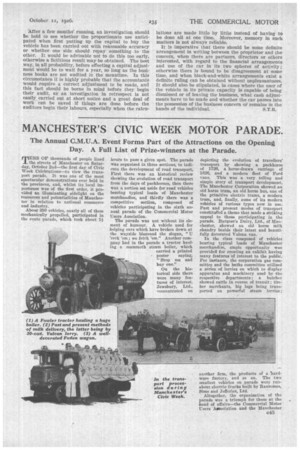• PROBLEMS OF THE HAULIER AND CARRIER
Page 66

Page 67

If you've noticed an error in this article please click here to report it so we can fix it.
Analysing and Allocating the Operating Costs of a Vehicle which•
is Used Both for Business and Private Purposes.
IN these days a motor vehicle is almost an essential for the shopkeeper and he also finds a private car avery pleasant thing for his leisure hours. A machine equipped with interchangeable bodies or dual-purpose coachwork obviously suggests itserf for this combination of purposes. One problem is to the fore in these circumstances, namely, costs and the proper allocation of expenses between the business and private accounts.
First comes the question of buying the car and the equitable distribution of the cost. As a rule, where a pair of interchangeable bodies are to be used a separate figure for eh can be obtained, the business paying its own share and the piivate motorist his portion. So far as-the chassis is concerned, the easiest plan will be to decide what percentage of use will be due to each of the two owners and to arrange accordingly. For example, the van body costs £60 and the private car body 150. The chassis costs £200 and the business work of the vehicle will be 60 per cent, of the total. The distribution will therefore be as follows :-
Business body £60, chassis proportion £120 = £180.
Private body £50, chassis proportion £80 = £130.
So, much for the initial outlay. Should it be found after, say, a year's work, that the estimated percentage of work was wrong, a correction should be made. For this purpose, and for general accountancy, a speedometer or mileometer is a necessity.
Dividing the Running Costs.
Now for running costs and their treatment. Obviously, it would be a very laborious job to consider every penny spent on the road and to deal with it bit by bit. The most simple plan is for the supplies purchased to be obtained by the firm and to be paid for by them. So soon as records have been established and a definite figure per mile for running costs can be decided, the private use can be charged against the individual on a mileage basis. The items to be considered in this manner will.be fuel, lubricants, tyres, maintenance and depreciation.
The last-named heading needs some elucidation. Obviously, as two parties bought the car, neither is responsible for the whole depreciation. The capital sums must be taken and a rate per mile for each decided. In view of the fact that the vehicle is partly a private car—therefore depreciating more quickly than a purely commercial vehicle—it will be a good plan to regard the car as being written off in five years; or after 75,000 miles. Each party will pay his proportion of the depreciation at a fixed rate per mile, according to the distance run.
An alternative scheme consists of each paying part of the total depreciation, in proportion to the capital involved in the first case, but, as the capital itself has to be adjusted when the proportionate mileage can be ascertained, it will be more simple to adhere to the mileage basis and to prevent the need for revision of figures at later dates. Standing charges are definitely known and these should be split up in proportion to the work done— that is, by mileage—weekly or monthly, as is preferred.
Having decided on the basis of working, the next thing is the method a application. A check should be made at the end of each week of the mileage recorded by the instrument on the car. The best time would be closing time for the business on Saturday, either mid-day or at night, as the case may be. Assuming a start is made with a new vehicle, the speedometer reading is noted in a book kept for the purpose either by an employee of the firm or the proprietor, and let us also assume that the van body is used until Saturday midday. Another mileage reading is then taken and the total expenditure. W.urred with regard to running costs and standing charges is noted down for calculation and the sum arrived at must be debited against the business, making proper allowance for maintenance and depreciation.
During Saturday afternoon and Sunday the proprietor fits the private body and uses it for his own pleasure. On Monday morning the person responsible for taking the mileage readings again carries ont his task and enters in the book the distance covered during , the week-end to be calculated upon the agreed basis and charged' against the private account of the business proprietor.
Checking a Simple Matter.
It may seem that there is a considerable amount of checking to be done, but, after all, it is only a matter of a moment or so on each occasion, and it is the only fair way of making the charges on a basis of relative use. If some system of fixed proportions were to be adopted, such as two-thirds of the total expenses to be paid by the firm and one-third by the proprietor, there might be considerable hardship on one side or the other. For instance, the private motorin,g in the winter might be quite a trivial matter, or the effect of seasonal trade would weigh heavily against the concern if the bulk of the business dwindled away, say, one month earlier, than usual, owing to weather conditions or other circumstances which affect individual trades.
On a stated day each week the mileage book should be taken and the private and business figures worked out according to the schedule drawn up and the bookkeeper of the concern should be instructed as to which sums he is to charge against the transport account of the business and which to the private account of the proprietor.
After a few months' running, an investigation should be held to see whether the proportionate use anticipated when first putting up the capital to buy the vehicle has been carried out with reasonable accuracy or whether one side should repay something to the other. It would be advisable not to do this too early,
• otherwise a fictitious result may be obtained. The best way, in all probability, before effecting a capital adjustment would be to wait for a year, so long as the business books are not audited in the meantime. In this circumstance it is highly probable that the accountants would require a correct adjustment to be made, and this fact should be borne in mind before they begin their audit, as an investigation in retrospect is not easily carried out at short notice and a great deal of work can be saved if things are clone before the auditors begin their labours, especially when the mien lations are made little by little instead of having to be done all at one time. Moreover, memory in such matters is not always reliable.
It is imperat4ve that there should be some definite arrangement in writing between the proprietor and the concern, when there are partners, directors or others interested, with regard to the financial arrangements and use of the car in its two spheres of activity ; otherwise there Is bound to be disagreement at some time, and when black-and-white arrangements exist a definite ruling can be obtained without unpleasantness. It should also be stipulated, in cases where the user of the vehicle in its private capacity is capable or being dismissed or of leaving the business, what cash adjustments have to be made and whether the car passes into the possession of the business concern of remains in the hands af the individual.












































































































